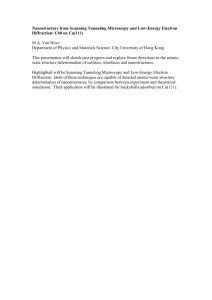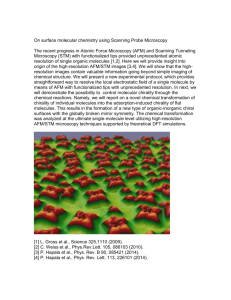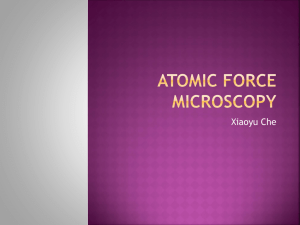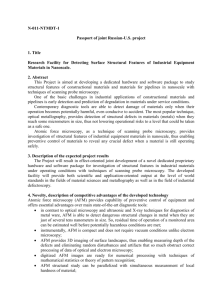Scanning Probe Microscopies
advertisement
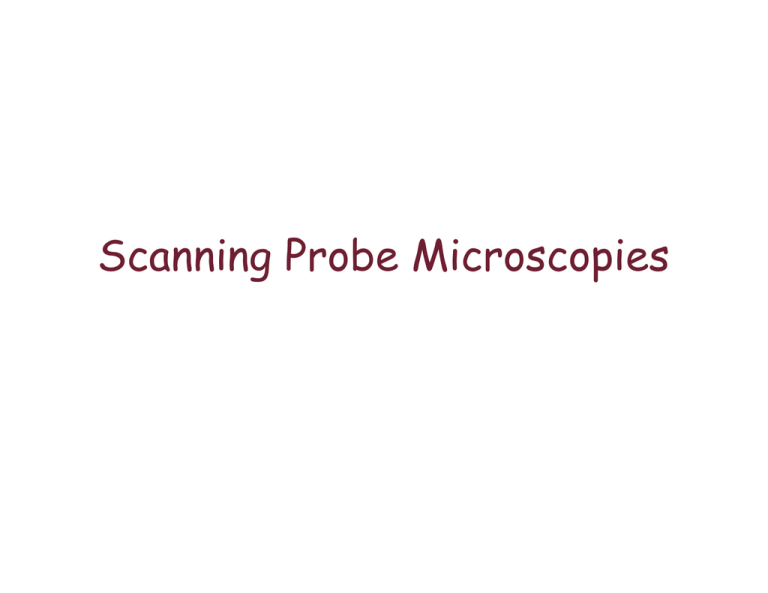
Scanning Probe Microscopies Outline • Microscopies Length Scales. • System requirements for scanning probe microscopies. – Piezo issues. – Image processing. • Near Field Scanning Optical Microscope (NSOM). • Scanning Tunneling Microscope (STM) • Atomic Force Microscope (AFM). Overview: Microscopy Techniques Characteristics of Common Microscopy Techniques Light Microscopy Scanning Electron (LM) Microscopy (SEM) Scanning Probe Microscopy (SPM) Sample Operating Environment Ambient Liquid Vacuum Vacuum Ambient Liquid Vacuum Depth of Field Small Large Medium Depth of Focus Medium Small Small Resolution (x,y) 1.0 micron 5 nm 0.1 - 3.0 nm Resolution (z) N/A N/A 0.1 nm Magnification Range 1X - 10 3X 10X - 10 6X 5 x 10 2X - 10 8X Sample Preparation Little Freeze drying, coating None Sample Requirements Sample must not Surface must not build up be completely charge and sample must be transparent to light vacuum compatible wavelength used Sample must not have excessive variations in surface height (~5 micron) Basic Principles & Hardware Principles of SPM Images acquired from Park Scientific Instruments Hardware Requirements • Coarse positioning system for probe approach. – Stepper motor. • Fine positioning system for sample imaging. – Piezo electric crystal. • Probe position sensor – Tuning fork (NSOM). – Laser (AFM). – Tunneling current (STM/AFM). • Feedback controller for probe position. – PI controller • Data acquisition system and GUI. Piezo Issues: Scanners Calibration Grid 10µm squares • piezocrystals – high precision positioning • non-linear response – creep, hysteresis – cross-coupling, resonances Adapted from: http://www.park.com • software/hardware correction Calibration: Piezo Nonlinearities Intrinsic Nonlinearity Creep Hysteresis Aging Nonlinearity plots adapted from Park Scientific Instruments Calibration: Piezo Nonlinearities Cross Coupling Piezo Nonlinear Effects Combined Nonlinearity plots adapted from Park Scientific Instruments NT-MDT TGX01 Calibration Grid Software Solutions: Calibration grating for lookup table Modeling of PZT non-linear response Corrections dependent on speed/direction Error up to 10% when scan conditions change Hardware Solutions: External sensors monitor scanner’s position Total nonlinearity less than 1% Image Processing • Piezo nonlinearities necessitate flattening. – Line by line fit polynomial. – Fit surface to plane. – Fourier methods. • Thresholding for counting particles. – User set. – Maximum entropy. • Roughness. • Facet orientation. • Tip reconstruction. • Polymer contours. Near Field Scanning Optical Microscopy NSOM NSOM • Resolution of optical microscope limited to ~ 1/2λ. • By passing light through a hole <λ and collecting detected light an image is constructed. http://physics.nist.gov/Divisions/Div844/facilities/nsom/nsom.html NSOM • Shear Force Mode. – Tuning fork oscillates probe & amplitude reduction on approach to surface is controlled. • Transmission mode. – Light passed through sample -> transparent sample. • Reflection mode. – Light reflected off the sample -> opaque sample. • Luminescence mode. – Light passed through sample and filtered. NSOM http://physics.nist.gov/Divisions/Div844/facilities/nsom/Fig5.jpg DNA Imaged by Shear Force NSOM DNA plasmid pGem7zf+ (Promega) 3000 b. p. linearized with the SmaI endonuclease deposited on freshly cleaved mica. DNA01 test sample was measured by Solver P47H using the Shear Force head. Humidity - 1-10%. http://www.ntmdt.com/Scan-gallery/SNOM/index.html Scanning Tunneling Microscopy STM We have experienced a revolution in surface analysis since the advent of the STM... In 1973, a Nobel Prize in Physics was given to Esak, Giaever and Josephson for their studies on electron tunneling. in 1978, H. Rohrer - a staff researcher at IBM Zurich G. Binnig - Graduate Student (Frankfurt) came to work with Rohrer January, 1979 - Binnig did some calculations: The Original Hypothesis The Revised Hypothesis r = 1000Å tunneling current falls off with distance between the surface and the tip 45Å 1Å STM •Calculations suggested that the tunneling current would only come from a 45Å area because of the exponential decay with distance. •March 18, 1981 - the first traces recorded on an x-y chart recorder •Soon after, Binnig and Rohrer note atomic sized features (versus the 45Å resolution they thought they had!). •Revised Hypothesis - small protuberances on the tip of their probe, not the tip radius, led to enhanced spatial resolution (Take note of the willingness to discard an unsatisfactory hypothesis and to develop a new hypothesis to explain the results. This "willingness" led to a Nobel Prize, 1986.) Appropriate to a Nobel Prize… The central concept nucleated a world of variants: • Scanning Tunneling Microscopy (STM) • Atomic Force Microscopy (AFM) • Friction/Lateral Force (FFM/LFM) • Electromagnetic modes (EFM/MFM/ECFM) • AC techniques – Force modulation (FMAFM) – Resonant drive (Tapping, Intermittant and Noncontact) • Surface indenters, nanolithography • Near-field optics (NSOM) • Chemical sensing (SFM-CS) • Also, NMR, thermal, optical, spectroscopy STM • 1981: Vacuum tunneling observed. – (Binnig, Rohrer, Gerber, Weibel; IBM Zurich) • 1986: Nobel prize award to Binnig and Rohrer. • The STM can create an image of: – the local electron density of states – contains topographic information – contains spectroscopic information – contains tip shape information STM Schematic • A simplification: – Quantum tunneling between two metallic electrodes, separated by a vacuum region. • J α exp(-Ak0d) – J = tunneling current – d = distance, Å; A = area – k0 = range of wavefunction out of solid (average inverse decay length) k0 • Adapted from: http://www.park.com = 1/2 (φ1 + φ 2) φ1 + φ 2 = work functions of two metals For a general work function: the tunneling current decreases about an order of magnitude for every angstrom ofseparation. STM Scan Modes Can be used to track surfaces that are not atomically flat Useful for rapid scanning (since only the electronics must respond -not the piezo) based upon: Hansma and Tersoff, J. Appl. Phys. 61(2), A1, (1987) Some STM Issues • Density of states vs. true topography. • Wire tips: platinum + rhodium/iridium, tungsten. – mechanically cut, electrochemically etched, ion milled. – tip shape is always convoluted into the image. • Conductive sample required in most cases. – can image insulators by working at very low tunneling currents (≈1pA), and high bias (1-5 V). • Imaging in conductive liquids (ie. saline) requires tip coating with insulator. • Interaction force decays by a factor of 2 slower than the tunneling current. Graphite Observed by STM Graphite is one of the easiest materials to observe by STM C C C C C d = 2.4Å C The six carbons making up the ring are not equivalent (3 of the carbons have neighboring atoms immediately below) By STM, three carbons in each ring will appear lower -actually they are not -- they just have different electron densities The tunneling current is proportional to the surface electric charge density (s.e.c.d.). Normally, the s.e.c.d. is where the atoms are, not not always! REMEMBER: STM measures electron density -- not topography Highly ordered pyrolytic graphite (HOPG) a=2.46Å STM and Surface Science • Pb on Cu(100) • Disordered surface alloy found at low coverages of Pb. • Deposition of 3:8 Pb:Cu surface atomic ratio results in a well-ordered surface structure. • Structural model: – bright "walls" of the maze are rows of Pb atoms – rows of Cu atoms between them (dark and unresolved in STM images). • Taken from: http://www.iap.tuwien.ac at/www/surface/STM_Gallery /Pb_on_Cu.html Gold Surfaces imaged with STM atomic resolution 300°C, 7 min. sputtered annealed 4.47x4.47x 0.5 nm 677x677x 60 nm 677x677x 20 nm Heights of features are coded in a scale from the lightest color to the darkest. Slide by Thomas Boland STM Fancy Stuff • D.M. Eigler, E.K. Schweizer. Positioning single atoms with a scanning tunneling microscope. Nature 344, 524-526 (1990). • Xenon on Nickel (110) Adapted from: http://www.almaden.ibm.com/st/ • M.F. Crommie, C.P. Lutz, D.M. Eigler, E.J. Heller. Waves on a metal surface and quantum corrals. Surface Review and Letters 2 (1), 127-137 (1995). • Iron on Copper (111) STM Spectroscopy • Current vs. Position spectroscopy I(z). – Determines tip quality. – Work function calculations. • Current vs. Voltage spectroscopy I(V). – High vacuum study of semiconductors. Atomic Force Microscopy AFM Atomic Force Microscopy Split Photodiode Detector Laser Feedback Control Y Sample Z X Piezoelectric Drive Cantilever Force versus Displacement Curves Approach E Retract F D B Force A I C H Position G A Cantilever approaches surface (thermal noise) B Snap to contact, tip is on surface (Hamaker constant) C “Attractive” work D Constant compliance region (Surface stiffness) E Hysteresis (viscous damping) F Retracting slope (surface stiffness) G “Adhesion” work (energy to separate surfaces) H Last bond(s) to break (“single bond forces”) I Cantilever is off surface AFM Cantilevers Small Cantilever 9-50µm long 3-5 µm wide Traditional Cantilever Image from Hansma Group - UCSB Calibration: Tip Characterization Adapted from Park Scientific Instruments Tip Characterization using NT-M DT TGT01 Undefined tip shape results in: Unknown degree of feature dilation Lack of quantitative ability without tip radius (R) Tip characterization solutions: Tip characterizer grids Blind tip reconstruction (Villarubia, 1997) Substitution with colloidal sphere Tip Shape Artifacts Cantilever Calibration • Many methods – large scale spring – 1/2kbT=1/2k<x2> – added mass Q shift – k=kbT/<x2> – thermal noise – k=2w(πlfo)3(ρ3/E)1/2 (Å^2) 0.2 • Thermal Noise displacement 0.4 K (N/m) 0.3 0.1 y = 2E -15x + 0.0882 2 R = 0.9379 0.2 k<P > Linear (k<P >) rms 0.1 0 0 2E +13 4E +13 6E +13 8E +13 1E +14 FR EQUENCY^3 (Hz^3) 0 1.0E+04 1.5E+04 Frequency (Hz) 2.0E+04 2.5E+04 1.2E +14 1.4E +14 SFM: Interaction Regimes • Forces Between Tip and Surface – Attractive Forces • Van der Waals • Electrostatic (hydrogen bonding) • Quantum mechanical • Hydrophobic • Ion correlation • Solvation (hydration force) • Specific binding – Repulsive Forces • Quantum mechanical (Core-core) • Van der Waals disjoining pressure • Electrostatic • Solvation (hydration force) Image acquired from Park Scientific Instruments • Entropic (steric forces, doublelayer forces) – Dynamic Interactions • Hydrodynamic forces • Viscous forces • Friction forces Lateral Force Mode Photodiode detection • Measures torsional deflections from forces parallel to surface • Frictional contrasts due to: – Interaction with different materials – Change in height (artifact) • Trace and retrace should be monitored to distinguish friction from height • Semi-quantitative Images acquired from Park Scientificmethod Instruments and DI – Torsional spring constant difficult Scanning Force Microscopy: Pulsed Force Mode • Pulsed Force Mode Operation – Simultaneous acquisition of topography, qualitative stiffness, semiquantitative adhesion – Piezo modulated 100 Hz - 2 kHz, amplitude of 10 - 500 nm – Complete force-distance cycle at repetition rate Topography Stiffness Adhesion – Peak pickers and lock-in amplifiers used to extract essential data, resulting in reduced data set – Non-destructive imaging technique used for polymers and soft samples Tapping/Intermittent Contact (IC-AFM) • Tip “taps” on sample (or hammers?) • Little sample degradation • Penetrates water layer Magnetic AC Mode (MAC Mode) • Oscillation magnetically induced • Frequency and amplitude controlled • Works well in fluids • Lower interaction forces Adapted from M olecular Imaging The oscillating magnetic field below the cantilever drives it directly. DMPC liposomes in pH 7.0 buffer From Molecular Imaging FN on Mica 1mg/ml 1min in PBS, Imaged in Air MAC mode, Scan Size 2000 nm x 2000 nm Imaging in Water – increasing the Q factor Frequency spectrum of a typical magnetically driven cantilever Imaging DNA Z range 3nm Q factor = 3 3µm 3µm Q factor = 300 Images courtesy Andy Round, University of Bristol Phase Imaging • With any of above modulated modes • Phase lag varies in response to surface mechanical properties Topography Phase Two Phase structure in a polymer blend Images from DI Living Cell Imaging Topographic image Z range 2.5 µm Simultaneous Phase Image z-range 60 degrees Images taken with an effective quality factor of 300. Image is 32 x 32 microns Images courtesy Rachel Owen, University of Bristol Masking techniques for measuring layer thicknesses Apply mask Apply coating Remove mask Masks from PDLA in acetone or polystyrene in toluene PG Hartley et al (2000) Plasmas and Polymers Plasma polymer thickness DLVO Theory and Force Curves I nter actio n Energy Double Layer Repulsion Separation (nm) Total van der Waals Attraction Scanning Force Microscopy: DLVO Analysis of Force Curve Data Derjaguin-Landau-Verway-Overbeek Theory: FDLVO ( z ) = Fel ( z ) + FvdW ( z ) = R = probe radius k = Boltzmann constant qi = component ionic valency ε0 = permittivity of free space Theory: (EDL) 4&R%s%p "e $e$ 0 ! z #d + ! AR 6z 2 #D = z = probe-sample separation ci = component concentration σs = surface charge density (sample) σp = surface charge density (probe) " 0" e kT e 2 ! ci qi2 = Debye length A = Hamaker constant T = temperature e = unit charge εe = electrolyte dielectric permittivity Ion cloud accumulates at surface to shield charge -> electric double layer Electric double layers overlap as surfaces approach -> EDL force (Fel) Van der Waals interaction provides strong attraction at small distances (FvdW) Assumptions: Interaction of spherical probe with flat plane Force curve is performed under aqueous conditions Derjaguin approximation valid only if R>>z Quantitation: Poisson-Boltzmann equation used to fit Fel(z) Debye length describes thickness of EDL Analysis typically performed by external software Yields semi-quantitative model of the force curve Colloid Probes Solutions for DLVO theory assume sphere on flat One component of the solution – Derjaguin approximation is only valid if R>>z Courtesy of Pat Hartley, CSIRO M olecular Science, Australia R = radius of sphere z =SEM tip-sample Sphere radius measured by or opticalseparation microscopy Polysaccharide Grafting 1. AApp Poly(ethyleneimine) Acetaldehyde plasma polymer H NH O H C 2. Graft PEI NH NH NH O C NaCNBH3 Reductive Amination Substrat e - 3. Graft CMD (carboxymethyl dextran) Vary COO- density - COO- - COO- - - COO- - - - - COOCOO- - COO- Substrate Substrat e Carbodiimide EDC/NHS Chemistry EDC/NHS Electrostatic interactions Silica probe vs grafted polyethyleneimine 0.1 F/R (mN/m) 0.05 0.15M NaCl 0 -0.05 -0.1 0.0015M NaCl -0.15 -0.2 0 10 20 30 Separation (nm) 40 50 60 Scanning Force Microscopy: Hertzian Analysis of Force Curves Hertzian Theory: Assumes elastic interaction between probe and sample. Assumes no adhesion in the contact regime. Used to determine sample stiffness. Modeled here with a rigid conical tip (other geometries may be used). z ! z0 = d ! d 0 + k tan(" ) d ! d0 K z = sample height z0 = sample height at contact k = cantilever spring constant K = reduced elastic modulus θ = opening angle between tip and surface d = cantilever deflection d0 = equilibrium deflection at contact Range of analysis: Domke & Radmacher, 1998 Necessary when soft samples are analyzed (z0 = ??) Generates two equations for the two unknowns (K, z0) Hertzian Analysis Force Distance Curves Indentation-Loading Force Curves (Converted from Force Distance Curves) 7.5 Silicon Indentation 5.5 14 PPNIPA M 37ºC 3.5 1.5 12 PPNIPAM 25ºC -0.5 -20 -15 -10 -5 0 5 10 Indentation (nm) Cantilever Deflection (nm) 9.5 37ºC 25ºC 10 8 6 4 2 Z-piezo Displacement (nm) 0 0.00 10 0.05 0.10 0.15 0.20 Indentation (nm) Loading Force (nN) 37ºC 25ºC 1 0.01 0.1 Loading Force (nN) Fit to Hertz Model 0.25 0.30 Tip Functionalization Tip Functionalization Strategies: • Alkylsilanes • Alkanethiols • RF-glow discharge React with X • LB film deposition XXXXXXXXXXXXX X • Biomolecule physisorption XXXXXXXX X • Sphere gluing X X Imaging contrasts due to: X • Hydrophobic/hydrophilic interactions • Van der Waals forces X • Friction differences X X • Specific recognition events X X X X attach X labeled bead PDMS Contamination on AFM tips (Lo et. al, 1999) NH2 NH2 Tip Functionalization OH DMSO O HO overnight Ethanolamine HCl S S O O 29 O NH2 O 29 CHCl3 O N O O O O N O N S N S NEt3 O SSIMS imaging of modified AFM cantilevers Biosensors and DNA arrays 1. Functionalize AFM tip with PNA 2. Look at force interactions with a Alkane thiol monolayer Biosensors and DNA arrays 3. Hybridize with target DNA or mutant DNA 4. Re-measure surface forces Analysis of Pull-off Forces Analyze distribution of pull-off forces a = PNA-modified tip b = PNA/DNA modified tip c = PNA/DNA mutant modified tip Able to detect single base mismatch in the analyte DNA Lioubashevski et al (2001) Langmuir ASAP Single Molecule Force Microscopy • Effects of Mechanical vs Chemical Stresses on proteins Force • Protein structure and unfolding – Titin module Data courtesy of Dr. J. Clarke, S. Fowler and A. Steward of Cambridge University, UK. Effects of Mutations on Protein Stability Point mutations in IgG I27 module All substitutions Pro Mechanical stability at A pulling rate of 0.6 nm/s Li et al Nat. Struc. Biol (2000) 7 1117 Dip Pen Nanolithography Image courtesy of Joseph Wei Still More …. Magnetic Force Microscopy (MFM) Kelvin Probe Microscopy (SKM) Electrostatic force microscopy (EEM) Scanning Capacitance Microscopy (SCM) Scanning Acoustical Microscopy Scanning Calorimetry Microscopy Magnetic forces Surface Potential Static charges Capacitance Acoustical waves Thermal conductivity Site Link List URL Advanced Surface Microscopy http://www.ai.com/asm Digital Instruments http://www.di.com/Biblio/biobib.html Blaine's SPM Page http://www.mcs.com/~wbstine/spm/spm.html Burleigh http://www.burleigh.com Digital Instruments http://www.di.com JEOL http://www.jeol.com Molecular Imaging http://www.molec.com Nanosensors http://www.nanosensors.com NT-MDT http://www.ntmdt.com Olympus http://www.olympus.co.jp/LineUp/Technical/Cantilever/levertopE.htm Omicron http://www.omicron-instruments.com/ A Practical Guide to Scanning Probe Microscopy http://www.thermomicro.com/spmguide/contents.htm RHK http://www.rhk-tech.com/main/pages/inddiv.html Scanning and Local Probe Technique Links http://www.embl-heidelberg.de/~altmann/ ThermoMicroscopes http://www.thermomicroscopes.com/ Witec http://www.witec.de

